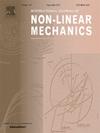Design of a piecewise-stiffening Nonlinear Energy Sink for torsional vibration attenuation
IF 3.2
3区 工程技术
Q2 MECHANICS
International Journal of Non-Linear Mechanics
Pub Date : 2025-09-12
DOI:10.1016/j.ijnonlinmec.2025.105248
引用次数: 0
Abstract
Torsional vibrations are undesirable in rotating machinery, and demands for better performance and material savings to reduce weight exacerbate this issue by triggering resonance conditions. The Nonlinear Energy Sink (NES) offers a robust and effective vibration attenuation solution. In this research, a 2 Degree-Of-Freedom torsionally vibrating host structure is equipped with a NES having piecewise-linear stiffness approximating a cubic nonlinearity. The first-order Complexification-Averaging (CxA) method is used to analyse the Slow Flow dynamics on the response envelope, and a NES tuning methodology based on the Slow Invariant Manifold is proposed for 1:1 resonance attenuation for two resonance frequencies of the host system. The mechanical design of the NES is optimised for minimal stresses and fatigue while avoiding local resonances of the individual components. Experiments and numerical simulations validate the CxA method, and indicate the presence of Strongly Modulated Response regime and an Isolated Resonance Curve in the vicinity of resonance. Significant resonant response attenuation is achieved for both the first mode () and the second mode () over a wide range of forcing amplitudes, with possibility of further improvements. In this regard, design modifications that allow for effective multi-modal attenuation are presented. As such, a complete toolchain has been developed to obtain an NES design which can be applied to a wide range of torsional vibration applications.
一种分段加强非线性减振能量池的设计
在旋转机械中,扭转振动是不受欢迎的,为了减轻重量,需要更好的性能和节省材料,从而引发共振条件,从而加剧了这一问题。非线性能量汇(NES)提供了一种鲁棒和有效的振动衰减解决方案。在本研究中,一个2自由度扭振主体结构配备了一个具有近似三次非线性的分段线性刚度的NES。采用一阶复化平均(CxA)方法分析了响应包络上的慢流动力学,并提出了一种基于慢不变流形的主机系统两个共振频率1:1共振衰减的NES调谐方法。NES的机械设计针对最小应力和疲劳进行了优化,同时避免了单个组件的局部共振。实验和数值模拟验证了该方法的有效性,并表明在谐振区附近存在强调制响应区和孤立共振曲线。在很宽的强迫幅度范围内,第一模态(>80%)和第二模态(>65%)都实现了显著的谐振响应衰减,并有可能进一步改进。在这方面,提出了允许有效的多模态衰减的设计修改。因此,已经开发了一个完整的工具链,以获得一个NES设计,可以应用于广泛的扭转振动应用。
本文章由计算机程序翻译,如有差异,请以英文原文为准。
求助全文
约1分钟内获得全文
求助全文
来源期刊
CiteScore
5.50
自引率
9.40%
发文量
192
审稿时长
67 days
期刊介绍:
The International Journal of Non-Linear Mechanics provides a specific medium for dissemination of high-quality research results in the various areas of theoretical, applied, and experimental mechanics of solids, fluids, structures, and systems where the phenomena are inherently non-linear.
The journal brings together original results in non-linear problems in elasticity, plasticity, dynamics, vibrations, wave-propagation, rheology, fluid-structure interaction systems, stability, biomechanics, micro- and nano-structures, materials, metamaterials, and in other diverse areas.
Papers may be analytical, computational or experimental in nature. Treatments of non-linear differential equations wherein solutions and properties of solutions are emphasized but physical aspects are not adequately relevant, will not be considered for possible publication. Both deterministic and stochastic approaches are fostered. Contributions pertaining to both established and emerging fields are encouraged.

 求助内容:
求助内容: 应助结果提醒方式:
应助结果提醒方式:


